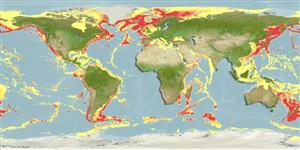Polychaeta |
Not assigned |
Capitellidae
Environment: milieu / climate zone / εύρος βάθους / distribution range
Οικολογία
; Υφάλμυρο; εύρος βάθους 0 - 2700 m (Αναφ. 119523). Polar; 27°C - 28°C (Αναφ. 87155)
Cosmopolitan: mainly in the northern hemisphere. Tropical to polar.
Length at first maturity / Μέγεθος / Weight / Age
Γεννητική Ωρίμανση: Lm ? range ? - ? cm Max length : 8.0 cm TL αρσενικό/απροσδιόριστο; (Αναφ. 75621)
Length based on occurrence record. Megabenthic species (Ref. 2952). Found in all sediment types but particularly in coarse to very fine substrate, very rarely in sediment without mud (Refs. 7882, 96352). Known from rocky shores, seagrass beds, cold seeps, hydrothermal vents, oxygen-minimum zones, whale carcasses. Depth ranges from intertidal, infralittoral, circalittoral to bathyal along gulfs and estuaries (Refs. 87155, 96352). Feeding type can vary from being a carnivore to a detritus feeder, to a grazer (Ref. 87155). Treated as a marine organic pollution indicator (Ref. 96352).
Life cycle and mating behavior
Γεννητική Ωρίμανση | Αναπαραγωγή | Γεννοβολία | Eggs | Γονιμότητα | Larvae
Members of the class Polychaeta are mostly gonochoric (sexual). Mating: Females produce a pheromone attracting and signalling the males to shed sperm which in turn stimulates females to shed eggs, this behavior is known as swarming. Gametes are spawned through the metanephridia or body wall rupturing (termed as "epitoky", wherein a pelagic, reproductive individual, "epitoke", is formed from a benthic, nonreproductive individual, "atoke"). After fertilization, most eggs become planktonic; although some are retained in the worm tubes or burrowed in jelly masses attached to the tubes (egg brooders). Life Cycle: Eggs develop into trocophore larva, which later metamorph into juvenile stage (body lengthened), and later develop into adults.
López-Jamar, E., G. González and J. Mejuto 1986 Temporal changes of community structure and biomass in two subtidal macroinfaunal assemblages in La Coruña bay, NW Spain. Hydrobiologia 142:137-150. (Αναφ. 2778)
IUCN Red List Status
(Αναφ. 130435: Version 2025-1)
CITES status (Αναφ. 108899)
Not Evaluated
Not Evaluated
Threat to humans
Human uses
| FishSource |
Εργαλεία
Περισσότερες πληροφορίες
Life cycleΑναπαραγωγήΓεννητική ΩρίμανσηΓονιμότηταΓεννοβολίαEggsEgg developmentLarvae PhysiologyΚατανάλωση οξυγόνου
Human RelatedStamps, coins, misc.
Διαδικτυακές πηγές
Estimates based on models
Preferred temperature
(Ref.
115969): 1.1 - 14.2, mean 5.9 (based on 1762 cells).
Fishing Vulnerability
Low vulnerability (10 of 100).
Price category
Unknown.
